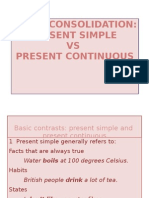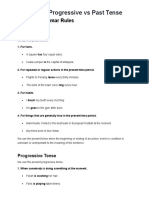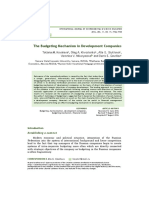Don't vs. Doesn't: English Grammar Rules
Don't vs. Doesn't: English Grammar Rules
Uploaded by
liaapriniCopyright:
Available Formats
Don't vs. Doesn't: English Grammar Rules
Don't vs. Doesn't: English Grammar Rules
Uploaded by
liaapriniOriginal Description:
Original Title
Copyright
Available Formats
Share this document
Did you find this document useful?
Is this content inappropriate?
Copyright:
Available Formats
Don't vs. Doesn't: English Grammar Rules
Don't vs. Doesn't: English Grammar Rules
Uploaded by
liaapriniCopyright:
Available Formats
Don't vs.
Doesn't
English Grammar Rules
To make a negative sentence in English we normally use Don't or Doesn't with all verbs
EXCEPT To Be and Modal verbs (Can, might, should etc.).
Affirmative: You speak Spanish.
Negative: You don't speak Spanish.
You will see that we add don't between the subject and the verb. We use Don't when the subject
is I, you, we or they.
Affirmative: He speaks Spanish.
Negative: He doesn't speak Spanish.
When the subject is he, she or it, we add doesn't between the subject and the verb to make a
negative sentence. Notice that the letter S at the end of the verb in the affirmative sentence
(because it is in third person) disappears in the negative sentence. We will see the reason why
below.
Contractions
Don't = Do not
Doesn't = Does not
I don't like fish = I do not like fish.
There is no difference in meaning though we normally use contractions in spoken English.
Word Order of Negative Sentences
The following is the word order to construct a basic negative sentence in English in the Present
Tense using Don't or Doesn't.
Subject
I / you / we / they
he / she / it
don't/doesn't
don't
doesn't
Verb*
have / buy
eat / like etc.
The Rest of the sentence
cereal for breakfast
*Verb: The verb that goes here is the base form of the infinitive = The infinitive without TO
before the verb. Instead of the infinitive To have it is just the have part.
Remember that the infinitive is the verb before it is conjugated (changed) and it begins with TO.
For example: to have, to eat, to go, to live, to speak etc.
Examples of Negative Sentences with Don't and Doesn't:
You don't speak Russian.
John doesn't speak French.
We don't have time for a quick drink.
It doesn't rain much in summer.
They don't want to come with us.
She doesn't like meat.
You might also like
- Do Does Did DoneDocument6 pagesDo Does Did Doneyiyi tan50% (2)
- 50 Contoh Soal TOEFL Reading Comprehension Lengkap Dengan Kunci Jawaban Dan Pembahasan Part ADocument19 pages50 Contoh Soal TOEFL Reading Comprehension Lengkap Dengan Kunci Jawaban Dan Pembahasan Part Aliaaprini89% (9)
- Simple Present Tense: English Grammar RulesDocument20 pagesSimple Present Tense: English Grammar RulesVidia darmayanthiNo ratings yet
- The Simple Present Tense Is UsedDocument8 pagesThe Simple Present Tense Is UsedNOOR AZNINo ratings yet
- Auxiliaries Do-Does-DidDocument5 pagesAuxiliaries Do-Does-DidValentina GUERRERO MARMOLEJONo ratings yet
- Silmple Present Tents: Verb Conjugation & SpellingDocument4 pagesSilmple Present Tents: Verb Conjugation & SpellingIta Masyita IskandarNo ratings yet
- The Simple Present Tense in English Is Used To Describe An Action That Is RegularDocument5 pagesThe Simple Present Tense in English Is Used To Describe An Action That Is RegularMarcos Augusto RomanNo ratings yet
- Ingles Basico 1Document19 pagesIngles Basico 1dulceNo ratings yet
- Present Simple YEnglishtubeDocument5 pagesPresent Simple YEnglishtubeA SNo ratings yet
- Simple Present TenseDocument6 pagesSimple Present TenseMuhammadiyah KotaProbNo ratings yet
- Simple Present Tense: English Grammar RulesDocument6 pagesSimple Present Tense: English Grammar RulesZahrotul JannahNo ratings yet
- Present Simple YEnglishtube PDFDocument5 pagesPresent Simple YEnglishtube PDFمحمد قاسمNo ratings yet
- Present Simple Tense in English - Grammar LessonDocument7 pagesPresent Simple Tense in English - Grammar LessonVerónica PilcoNo ratings yet
- Simple Present TenseDocument9 pagesSimple Present TenseWahyu Budi SulistiawanNo ratings yet
- Present Simple TheoryDocument5 pagesPresent Simple TheorySimona MariaNo ratings yet
- Simple Present Tense: English Grammar RulesDocument6 pagesSimple Present Tense: English Grammar Rulesrosmaniza ismailNo ratings yet
- Don't vs. Doesn't: English Grammar RulesDocument2 pagesDon't vs. Doesn't: English Grammar Rulesfilippo.fiNo ratings yet
- 1 Lectura de InglesDocument9 pages1 Lectura de InglesLiisdey JiimenezNo ratings yet
- Present Simple Tense - UtpDocument5 pagesPresent Simple Tense - UtpMiguel Galvez100% (1)
- Simple Present Tense and Past TenseDocument23 pagesSimple Present Tense and Past TenseLisa Aulia100% (1)
- The Simple Present TensesDocument3 pagesThe Simple Present TensesrharshaohmNo ratings yet
- Simple Present Tense Uses and RulesDocument6 pagesSimple Present Tense Uses and RulesMaurizio Iparraguirre GarcíaNo ratings yet
- Present Simple Lesson FarahDocument5 pagesPresent Simple Lesson Farahfarahmebrouk96No ratings yet
- Simple PresentDocument7 pagesSimple PresentJosmary Cuauro QuiñonezNo ratings yet
- The Simple Present Tense and Frequency AdverbsDocument5 pagesThe Simple Present Tense and Frequency AdverbsBrayan Ramirez0% (1)
- TENSE Consolidation Simp. Pres. Vs Pres. Cont.Document21 pagesTENSE Consolidation Simp. Pres. Vs Pres. Cont.tatianypertelNo ratings yet
- Dont Give UpDocument10 pagesDont Give UpyiswilNo ratings yet
- Unidad 1. Recurso 1. Rules For The Simple Present TenseDocument3 pagesUnidad 1. Recurso 1. Rules For The Simple Present TensejuanhenriquezrosarioNo ratings yet
- The Simple Present TenseDocument19 pagesThe Simple Present TenseJavier Gustavo Chuco ChucoNo ratings yet
- 1.INTERMEDIATE PLUS - PEDAGOGICAL GRAMMAR - Simple PresentDocument5 pages1.INTERMEDIATE PLUS - PEDAGOGICAL GRAMMAR - Simple PresentAntonio MonteiroNo ratings yet
- 3 ModuleDocument11 pages3 ModuleIndah safitriNo ratings yet
- WRITING 1 Simple PresentDocument5 pagesWRITING 1 Simple PresentSyaiful RullyNo ratings yet
- Present Vs Progressive Vs Past TenseDocument8 pagesPresent Vs Progressive Vs Past TenseNur Saidatul AkhmalNo ratings yet
- KP English HomeDocument14 pagesKP English Homepy27hlNo ratings yet
- Simple Present UseDocument8 pagesSimple Present Usesuanfonson ruizNo ratings yet
- 3B - 074 - Septi Dimas Jamaludin - 3 - MODULEDocument11 pages3B - 074 - Septi Dimas Jamaludin - 3 - MODULEGanryuNo ratings yet
- I Do Not Cook. - EngooDocument4 pagesI Do Not Cook. - EngooSandra SorianoNo ratings yet
- Name: Ahmed Ameer Shaker Department: Mechanical Engineering Stage: First - Evening Group: - BDocument8 pagesName: Ahmed Ameer Shaker Department: Mechanical Engineering Stage: First - Evening Group: - Bson gokuNo ratings yet
- Do vs. Does: English Grammar RulesDocument4 pagesDo vs. Does: English Grammar RulesDavidRodriguezNo ratings yet
- Present Simple Vs Present ContinuousDocument8 pagesPresent Simple Vs Present Continuousmzt messNo ratings yet
- Simple Present TenseDocument18 pagesSimple Present Tensehappyindriyono2402No ratings yet
- Clase 4-Gimenez-Verb To Be - Simple PresentDocument12 pagesClase 4-Gimenez-Verb To Be - Simple PresentPabloNo ratings yet
- English Grammar RulesDocument105 pagesEnglish Grammar RulesAnonymous vRpzQ2BLNo ratings yet
- English Lessons AlfonsoDocument92 pagesEnglish Lessons AlfonsoalkfonsoNo ratings yet
- Present Simple Tense in English Woodward EnglishDocument1 pagePresent Simple Tense in English Woodward EnglishGimena QuerciNo ratings yet
- Everything About "Do"Document9 pagesEverything About "Do"Amy ZuraidaNo ratings yet
- Simple Present Tense in English - Grammar Rules and NotesDocument6 pagesSimple Present Tense in English - Grammar Rules and NoteszilvherNo ratings yet
- ENGLISH 4 GuideDocument30 pagesENGLISH 4 GuidewilliamNo ratings yet
- English 4 VCDocument32 pagesEnglish 4 VCJavier CastelblancoNo ratings yet
- The Grammar GameshowDocument29 pagesThe Grammar GameshowOkan Taşin100% (1)
- English 4 VCDocument33 pagesEnglish 4 VCcarolina Leon CastroNo ratings yet
- English III Module 2 Simple Present Job and Job VerbsDocument4 pagesEnglish III Module 2 Simple Present Job and Job VerbsAdrian CortesNo ratings yet
- Ammar Rules Intermediate PDFDocument73 pagesAmmar Rules Intermediate PDFjoanna manabatNo ratings yet
- Do Does Did Done - English GrammarDocument1 pageDo Does Did Done - English Grammarvargas199511No ratings yet
- Grammar Notes 1A:: Singular and Plural NounsDocument5 pagesGrammar Notes 1A:: Singular and Plural NounsSalah ElbakkoushNo ratings yet
- Verb TensesDocument33 pagesVerb TensesThiago Teixeira100% (5)
- Present ContinuousDocument3 pagesPresent ContinuousILy SofiaNo ratings yet
- Do vs. Does: English Grammar RulesDocument4 pagesDo vs. Does: English Grammar RulesIgnacio LeivaNo ratings yet
- The Budgeting Mechanism in Development Companies: Open AccessDocument19 pagesThe Budgeting Mechanism in Development Companies: Open AccessliaapriniNo ratings yet
- SIPE-6687 - CamerafullpaperDocument17 pagesSIPE-6687 - CamerafullpaperliaapriniNo ratings yet
- PAK 6664 CamerafullpaperDocument14 pagesPAK 6664 CamerafullpaperliaapriniNo ratings yet
- Muhammad Nazmudin Nurrasyid-Feb PDFDocument181 pagesMuhammad Nazmudin Nurrasyid-Feb PDFliaapriniNo ratings yet
- Implication of Right Issue Cum and Ex-Date Announcement To The Stock Return (Empirical Study On Indonesia Stock Exchange PERIOD:2009-2012)Document16 pagesImplication of Right Issue Cum and Ex-Date Announcement To The Stock Return (Empirical Study On Indonesia Stock Exchange PERIOD:2009-2012)liaapriniNo ratings yet
- Budgets and Budgetary ControlDocument7 pagesBudgets and Budgetary ControlliaapriniNo ratings yet
- 1142 3036 1 SMDocument19 pages1142 3036 1 SMliaapriniNo ratings yet



































































